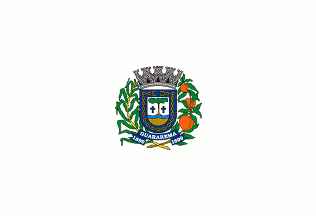 image by Dirk Schönberger,
5 November 2012
image by Dirk Schönberger,
5 November 2012Source: http://pt.wikipedia.org/wiki/Guararema

Last modified: 2012-12-15 by ian macdonald
Keywords: sao paulo | guararema |
Links: FOTW homepage |
search |
disclaimer and copyright |
write us |
mirrors
 image by Dirk Schönberger,
5 November 2012
image by Dirk Schönberger,
5 November 2012
Source:
http://pt.wikipedia.org/wiki/Guararema
A white flag with the municipal arms centred.
Official website at
http://www.guararema.sp.gov.br
Dirk Schönberger,
3 November 2012
Guararema originates in the establishment by Gaspar Vaz in 1611 of the settlement of Escada, on a strategic place located on the road linking São Paulo and Rio de Janeiro. The Jesuit fathers built a chapel in 1652. On 15 December 1732, Sebastião Silva, a native who had taken a Portuguese name, was appointed Captain of the Indians of Escada, and the original chapel was replaced by a new one. Two years later, the Franciscans built a convent nearby; representative of the Brazilian colonial architecture, the building was registered on 25 January 1941 on the list of National Historical and Artistic Heritage. This is the only church in Brazil with a statue of St. Longinus - invoked to recover lost stuff - on the altar. The chapel was dedicated to Our Lady of the Conception, while the place was renamed Nossa Senhora da Escada. The origin of the name of Escada is not know. It is generally believed that it refers to the ladder ("escada") that the natives placed on the tombs to help the dead souls to climb to the Kingdom of Tupã ; the Christian fathers might have reused the name for their sanctuary to facilitate evangelization. The parish of Escada was established on 9 February 1846 by Law No. 9 and suppressed on 23 May 1850 by Law No. 6, following the exodus of the villagers to other places. The district of Escada was eventually established on 28 February 1872 by Law No. 1. In 1875, Laurinda de Souza Leite offered to her former slave Maria Florência a piece of land located on the bank of river Paraíba, 3.5 km from Escada. Maria Florência built there a chapel dedicated to her patron saint, St. Benedict. The village that developed around the chapel was named Guararema. The seat of the district of Escada was transferred to Guararema on 8 January 1890 by Decree No. 8. The municipality of Guararema was established on 3 June 1898 by Law No. 528 and inaugurated on 19 September 1899.
The flag of Guararema is white with the municipal coat of arms in the middle.
Photo of the flag, hoisted on the historical locomotive "Maria Fumaça" http://www.guararema.sp.gov.br/661/maria+fumaca/>
The coat of arms of Guararema is "Or an ajo ajo tree proper issuant from a fess wavy azure and surrounded by two Christian crosses of the same, a bordure azure charged with a chain or broken in chief. The shield surmounted by an eight-towered mural crown argent ports sable. The shield supported dexter by a sugar cane and sinister by a branch of peach tree the two proper. Below the shield a scroll or inscribed with the toponym 'GUARAREMA' surrounded by the years '1898' and '1899' azure."
The rounded-off - or Iberic - shield, used in Portugal at the time of the discovery of Brazil, is a tribute to the early colonizers and builders of the country. Or is a symbol of wealth, splendour, glory, nobleness, power, force, faith, prosperity, sovereignty and rule. Azure is a symbol of justice, beauty, nobleness, recreation, vigilance, serenity, constancy, incorruptible firmness, dignity, zeal and loyalty. The ajo ajo tree, aka pau d'alho (lit. "garlic pine", recalling that the tree exhales a stench of garlic from every part; known to botanists as Gallesia integrifolia (Spreng.) Harms) makes the arms canting, since the town is named for the Tupi name of this tree. The fess wavy represents river Paraíba do Sul that waters the municipality. The two crosses represent the chapel dedicated to Our Lady of Escada, built in 1654 by the Capuchins and the St. Benedict chapel built by the former slave Maria Floréncia. The crosses also highlight the deep Christian faith of the inhabitants. The bordure is a symbol of protection, favour and reward. The broken chain means liberty, emancipation, concord and fidelity. It stands for the former slave Maria Floréncia, who, once liberated, decided to live in religion. The mural crown is a symbol of political emancipation. Its open ports are a symbol of hospitality. The sugar cane and the peach tree symbolize the fertility of the soil, being the main crops in Guararema.
http://www.guararema.sp.gov.br/56/institucional/simbolos+oficiais/brasao - Municipal website
Ivan Sache, 10 November 2012